100+ Cinquain Poem Examples
Poetry, a captivating literary element, allows writers to express emotions, ideas, and stories in a unique and creative way. Among the various poetic forms, the cinquain poem stands as a concise yet expressive structure that can convey profound thoughts and sentiments. In this article, we will delve into the world of cinquain poetry, exploring its definition, the steps to craft one, and providing you with captivating examples to inspire your poetic journey.
What is a Cinquain Poem?
A Cinquain poem is a short, structured form of poetry that consists of five lines, each with a specific syllable count or a particular word pattern. The most common Cinquain form, inspired by Adelaide Crapsey, follows a syllable pattern of 2-4-6-8-2. Another popular form adheres to a word count pattern, where the poem is structured as follows: one word (title), two words (description), three words (action), four words (feeling or effect), and one word (conclusion or synonym for the title).
Cinquain Poem Format
A cinquain is a five-line poem with a specific structure and pattern. Here are the common formats for writing a cinquain:
1. Traditional Cinquain
Developed by Adelaide Crapsey, the traditional cinquain follows a syllable count pattern:
- Line 1: 2 syllables
- Line 2: 4 syllables
- Line 3: 6 syllables
- Line 4: 8 syllables
- Line 5: 2 syllables
Example:
Water
Lapping gently
Against the silent shore
Soft whispers in the cool twilight
Calmness
2. Word Count Cinquain
This format uses a word count pattern rather than syllables:
- Line 1: 1 word (title)
- Line 2: 2 words (describing the title)
- Line 3: 3 words (expressing action)
- Line 4: 4 words (expressing a feeling or deeper meaning)
- Line 5: 1 word (synonym or summary of the title)
Example:
Snow
Silent, white
Falling, drifting, covering
Blanketing all in peace
Winter
3. Didactic Cinquain
The didactic cinquain focuses on specific types of words for each line:
- Line 1: 1 noun
- Line 2: 2 adjectives
- Line 3: 3 -ing words (gerunds)
- Line 4: A phrase
- Line 5: 1 noun (related to or a synonym of the first noun)
Example:
Tree
Sturdy, tall
Growing, reaching, sheltering
A home for birds
Oak
How to Write a Cinquain Poem
Using the Syllable Count Method:
- Line 1: Start with a two-syllable word or title that introduces the subject of your poem.
- Line 2: Write a line with four syllables that describes your subject.
- Line 3: Use six syllables to express an action related to your subject.
- Line 4: Compose an eight-syllable line that conveys a feeling or observation about your subject.
- Line 5: Conclude with a two-syllable word or phrase that summarizes or reflects on the essence of your poem.
Using the Word Count Method:
- Line 1: Begin with a single word that names your subject.
- Line 2: Choose two words that describe your subject.
- Line 3: Use three words to detail an action related to your subject.
- Line 4: Write four words that describe a feeling or effect associated with your subject.
- Line 5: End with a single word that restates or summarizes the theme or essence of your poem.
General Tips:
- Choose Your Words Carefully: Since Cinquain poems are concise, each word must be carefully chosen to convey your message effectively.
- Focus on Imagery: Use vivid imagery to create a strong picture or emotion in the reader’s mind.
- Revise and Edit: Don’t be afraid to revise your poem. Experimenting with different words or phrases can significantly impact your poem’s effectiveness.
- Read Out Loud: Reading your Cinquain aloud can help you catch any awkward phrasing or syllable count errors.
Six Cinquain Variations
Cinquain poems are versatile, offering several variations that cater to different styles and preferences. Here are six variations of Cinquain poetry, each with its unique structure or thematic focus:
1. Crapsey Cinquain
- Inspired by Adelaide Crapsey, this traditional form consists of five lines with a syllable pattern of 2-4-6-8-2. It often focuses on imagery and emotion, capturing a moment or feeling with precise language.
2. Didactic Cinquain
- This educational variation is often used in schools. It follows a pattern based on word count rather than syllables: one word (subject or title), two words (description), three words (action), four words (feeling or effect), and one word (conclusion or synonym of the title).
3. Reverse Cinquain
- A twist on the traditional form, the reverse cinquain flips the syllable pattern to 2-8-6-4-2. This format allows for a different rhythmic flow and can be used to challenge or expand a poet’s creative expression.
4. Mirror Cinquain
- Combining a Crapsey cinquain with its reverse, this variation consists of two five-line stanzas with syllable counts of 2-4-6-8-2 and then 2-8-6-4-2. The mirror cinquain offers a balanced, reflective structure, perfect for exploring contrasting themes or creating a more comprehensive poetic picture.
5. Butterfly Cinquain
- Also known as a “Cinquain Chain,” this variation expands on the Crapsey Cinquain with a syllable pattern of 2-4-6-8-2-8-6-4-2. The shape of the poem on the page resembles a butterfly, adding a visual element to the poetic structure.
6. Crown Cinquain
- A crown cinquain is a series of five Crapsey cinquains linked together to form a longer, more complex poem. Each cinquain in the series can stand alone but is also part of a cohesive larger piece, allowing for an extended exploration of a theme or story.
The Rules of a Cinquain
The rules of a Cinquain poem focus on structure, syllable count, and sometimes word count, depending on the variation you choose to follow. Here’s a breakdown of the general rules for writing a traditional Cinquain, inspired by Adelaide Crapsey:
Line and Syllable Structure
- Line 1: Consists of 2 syllables.
- Line 2: Comprises 4 syllables.
- Line 3: Contains 6 syllables.
- Line 4: Features 8 syllables.
- Line 5: Returns to 2 syllables.
Content and Theme
- Imagery and Emotion: Cinquains often convey a vivid image or emotion through concise and impactful language. The poem should evoke a strong sense of imagery or feeling using minimal words.
- Focus: The poem typically focuses on a single subject, concept, or idea. It may describe a scene, an object, an emotion, or an action, capturing the essence in a few lines.
- Tone and Mood: The tone can vary widely, from contemplative, joyful, and serene to somber and reflective. The mood should align with the poem’s subject and the emotion you wish to convey.
Formatting and Style
- Centered Text: Traditionally, Cinquain poems are centered on the page to enhance their visual appeal and to emphasize the poem’s structure.
- Capitalization and Punctuation: Use capitalization and punctuation as tools to enhance the poem’s rhythm, mood, and meaning, but there are no strict rules. Poets have the freedom to use these elements creatively.
Variations
While the traditional Cinquain follows the rules outlined above, there are several variations (e.g., Reverse Cinquain, Mirror Cinquain, Butterfly Cinquain) that introduce different syllable counts and structures, allowing for flexibility and creative expression.
10 Cinquain Poem samples
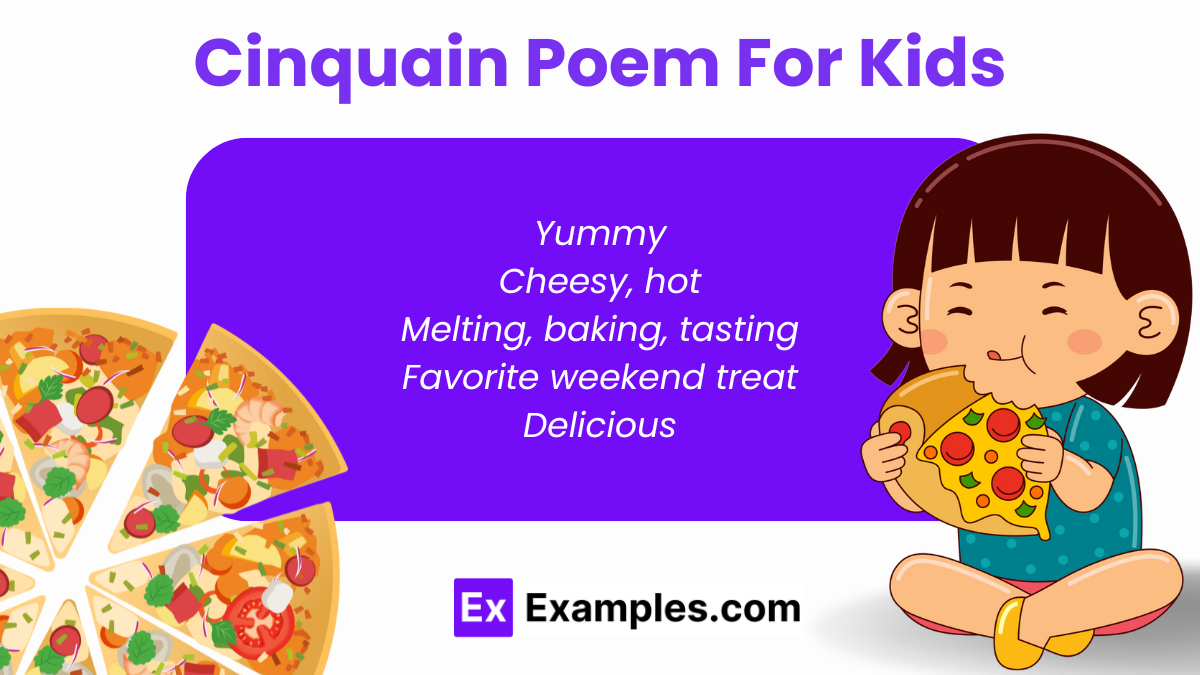
- Forest
- Trees stand
- Whispering leaves
- Secrets kept in shadows
- Nature’s ancient guardians
- Silent
- Winter
- Frost bites
- Icy pavements
- Breath turns to mist in air
- A world asleep, dreaming deep
- Cold
- Dawn
- First light
- Horizon blushes
- Night’s cloak gently lifting
- Promise of new beginnings
- Hope
- River
- Clear flow
- Over smooth stones
- Carving earth, ever on
- Lifeblood of the meadows
- Moving
- Eagle
- Broad wings
- Circling high
- Master of the blue sky
- Freedom personified
- Soar
- Library
- Quiet halls
- Books line the walls
- Worlds trapped in paper wait
- Imagination’s gate
- Knowledge
- Music
- Soft notes
- Melodies weave
- Rhythms dance, spirits lift
- Universal language
- Harmony
- Friendship
- Trust, love
- Laughter shared
- Comfort in silence found
- Bonds that withstand time’s test
- Precious
- Storm
- Clouds loom
- Thunder rumbles
- Nature’s fury unleashed
- Rain washes the earth clean
- Renew
- Desert
- Vast sands
- Sunbaked, arid
- Oasis mirages
- Survivors in silence
- Barren
Examples of Cinquain Poem
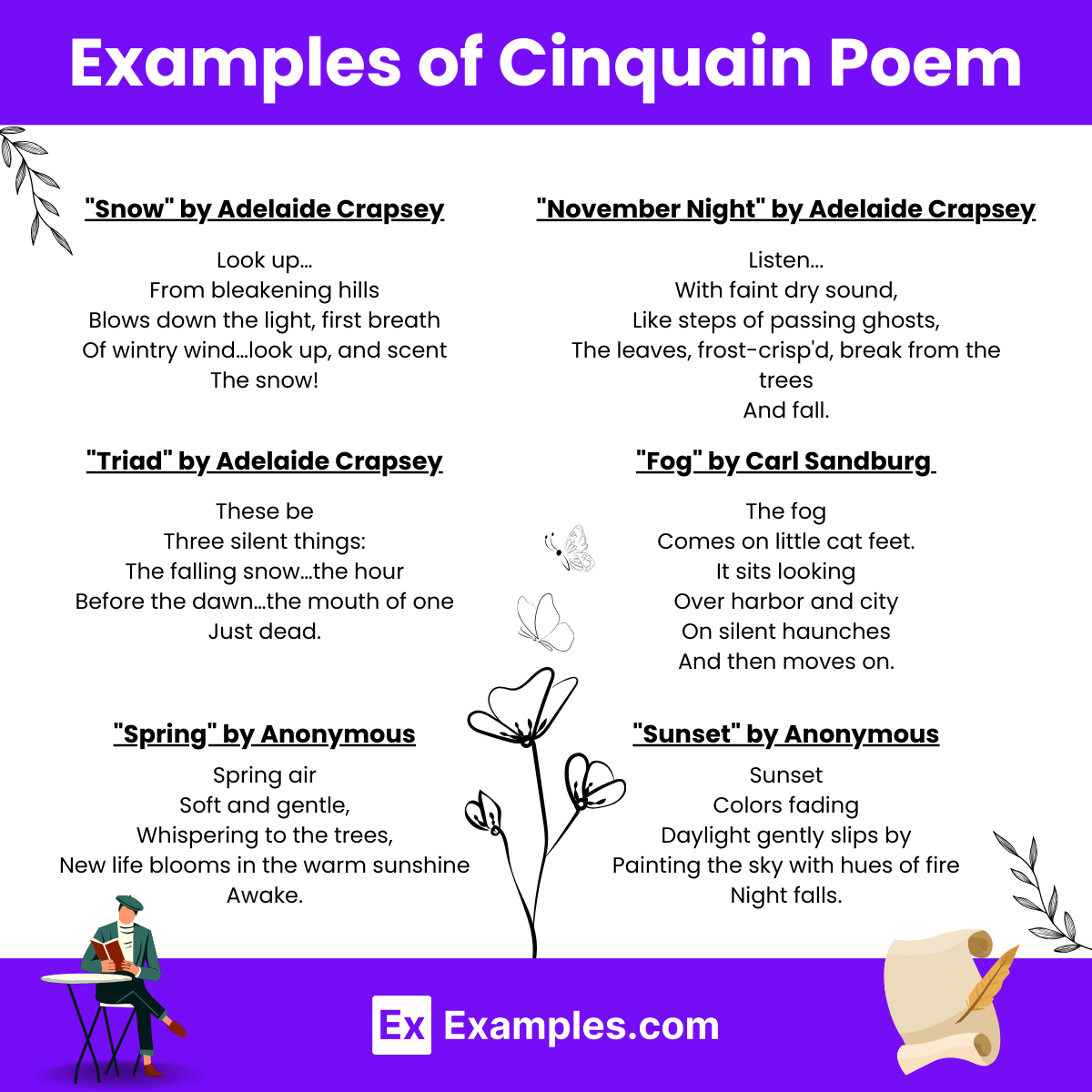
Cinquain Poem Examples for Students
Cinquain poems are simple, five-line poems that follow a specific format, making them perfect for students to practice and enjoy. Here are some examples to inspire students:
Traditional Cinquain
Format:
- Line 1: 2 syllables
- Line 2: 4 syllables
- Line 3: 6 syllables
- Line 4: 8 syllables
- Line 5: 2 syllables
Example 1:
Puppies
Playful, fluffy
Jumping, running, chewing
Bringing joy to our hearts
Furry
Example 2:
Rainbow
Colors shining
Arcing through the sky
A beautiful, bright surprise
Magic
Word Count Cinquain
Format:
- Line 1: 1 word (title)
- Line 2: 2 words (describing the title)
- Line 3: 3 words (expressing action)
- Line 4: 4 words (expressing a feeling or deeper meaning)
- Line 5: 1 word (synonym or summary of the title)
Example 1:
Spring
Fresh blooms
Birds are singing
New life everywhere awakens
Renewal
Example 2:
Beach
Sunny, sandy
Waves are crashing
Children laughing and playing
Paradise
Didactic Cinquain
Format:
- Line 1: 1 noun
- Line 2: 2 adjectives
- Line 3: 3 -ing words (gerunds)
- Line 4: A phrase
- Line 5: 1 noun (related to or a synonym of the first noun)
Example 1:
Kitten
Soft, tiny
Purring, playing, napping
Chasing a ball of yarn
Feline
Example 2:
Sunset
Bright, colorful
Glowing, fading, ending
A canvas painted with light
Dusk
Examples for Younger Students
Example 1:
Star
Shining bright
Twinkling in space
Guiding travelers at night
Light
Example 2:
Tree
Tall, green
Growing, swaying, shading
Home to birds and squirrels
Nature
Examples for Older Students
Example 1:
Mountain
Majestic, high
Climbing, standing, gazing
Reaching for the endless sky
Summit
Example 2:
Dreams
Vivid, surreal
Floating, drifting, escaping
Visions of a hidden world
Fantasies
Cinquain Poem Examples for Kids
Here are some fun and easy cinquain poem examples that kids can enjoy and use as inspiration to write their own poems.
Traditional Cinquain
Format:
- Line 1: 2 syllables
- Line 2: 4 syllables
- Line 3: 6 syllables
- Line 4: 8 syllables
- Line 5: 2 syllables
Example 1: Butterfly
Butterfly
Colorful wings
Flying in the air
Dancing on flowers so bright
Beauty
Example 2: Ice Cream
Ice cream
Cold and sweet
Melting in the sun
Chocolate, vanilla, strawberry
Delicious
Word Count Cinquain
Format:
- Line 1: 1 word (title)
- Line 2: 2 words (describing the title)
- Line 3: 3 words (expressing action)
- Line 4: 4 words (expressing a feeling or deeper meaning)
- Line 5: 1 word (synonym or summary of the title)
Example 1: Playground
Playground
Fun, exciting
Running, jumping, laughing
Children playing all day
Joy
Example 2: Snowman
Snowman
Frosty, happy
Building, smiling, melting
Wearing a hat, scarf
Winter
Didactic Cinquain
Format:
- Line 1: 1 noun
- Line 2: 2 adjectives
- Line 3: 3 -ing words (gerunds)
- Line 4: A phrase
- Line 5: 1 noun (related to or a synonym of the first noun)
Example 1: Puppy
Puppy
Cute, playful
Barking, wagging, running
Always full of energy
Dog
Example 2: Rainbow
Rainbow
Bright, colorful
Shining, glowing, arching
A promise in the sky
Spectrum
Examples for Younger Kids
Example 1: Balloon
Balloon
Big, round
Floating, flying, soaring
Rising high above clouds
Air
Example 2: Cat
Cat
Soft, fluffy
Purring, sleeping, playing
Loves to chase the red dot
Feline
Examples for Older Kids
Example 1: Rocket
Rocket
Fast, powerful
Blasting, soaring, exploring
Reaching the stars above
Spaceship
Example 2: Jungle
Jungle
Dense, wild
Roaring, rustling, chirping
Home to many creatures
Rainforest
Cinquain Poem Examples about Nature
Here are some cinquain poems about nature that capture the beauty and essence of the natural world. These examples use different forms of the cinquain structure to express various elements of nature.
Traditional Cinquain
Format:
- Line 1: 2 syllables
- Line 2: 4 syllables
- Line 3: 6 syllables
- Line 4: 8 syllables
- Line 5: 2 syllables
Example 1: Ocean
Ocean
Deep and blue
Waves crashing to shore
Endless horizon stretching far
Calmness
Example 2: Forest
Forest
Tall, green trees
Whispering in breeze
Home to many animals
Shelter
Word Count Cinquain
Format:
- Line 1: 1 word (title)
- Line 2: 2 words (describing the title)
- Line 3: 3 words (expressing action)
- Line 4: 4 words (expressing a feeling or deeper meaning)
- Line 5: 1 word (synonym or summary of the title)
Example 1: River
River
Flowing, winding
Rushing over rocks
Bringing life to land
Stream
Example 2: Meadow
Meadow
Green, peaceful
Swaying, blooming, resting
A carpet of flowers
Grassland
Didactic Cinquain
Format:
- Line 1: 1 noun
- Line 2: 2 adjectives
- Line 3: 3 -ing words (gerunds)
- Line 4: A phrase
- Line 5: 1 noun (related to or a synonym of the first noun)
Example 1: Mountain
Mountain
Majestic, tall
Rising, standing, towering
A peak that touches sky
Summit
Example 2: Rain
Rain
Gentle, steady
Falling, soaking, refreshing
Nourishing the thirsty earth
Showers
Examples Focused on Specific Elements of Nature
Example 1: Sunset
Sunset
Brilliant hues
Painting the sky
Ending the day with light
Dusk
Example 2: Snow
Snow
White, fluffy
Falling, covering, sparkling
Blanketing the quiet earth
Winter
Example 3: Breeze
Breeze
Cool, gentle
Whispering through trees
Bringing sweet relief
Zephyr
Example 4: Flower
Flower
Bright, blooming
Growing, opening, thriving
A splash of color
Blossom
Example 5: Moon
Moon
Silver orb
Glowing in night
Lighting up the dark sky
Luna
Cinquain Poem Examples on Sunset
Here are some cinquain poems that capture the beauty and tranquility of sunsets. These examples use different forms of the cinquain structure to express the various elements and emotions associated with sunsets.
Traditional Cinquain
Format:
- Line 1: 2 syllables
- Line 2: 4 syllables
- Line 3: 6 syllables
- Line 4: 8 syllables
- Line 5: 2 syllables
Example 1: Sunset
Sunset
Golden glow
Sinking into night
Colors fade as stars appear
Twilight
Example 2: Evening
Evening
Sky ablaze
Colors blend and mix
Day gives way to calm nightfall
Quiet
Word Count Cinquain
Format:
- Line 1: 1 word (title)
- Line 2: 2 words (describing the title)
- Line 3: 3 words (expressing action)
- Line 4: 4 words (expressing a feeling or deeper meaning)
- Line 5: 1 word (synonym or summary of the title)
Example 1: Sunset
Sunset
Brilliant, serene
Fading, glowing, ending
A beautiful day’s close
Dusk
Example 2: Horizon
Horizon
Golden, pink
Dipping, spreading, calming
Nature’s evening masterpiece
Sunset
Didactic Cinquain
Format:
- Line 1: 1 noun
- Line 2: 2 adjectives
- Line 3: 3 -ing words (gerunds)
- Line 4: A phrase
- Line 5: 1 noun (related to or a synonym of the first noun)
Example 1: Sunset
Sunset
Colorful, serene
Blazing, fading, resting
The sky painted with hues
Nightfall
Example 2: Sky
Sky
Wide, open
Changing, glowing, dimming
A canvas of colors
Twilight
Examples Focused on the Imagery of Sunset
Example 1: Colors
Colors
Red and gold
Splashing across sky
Daylight gives way to night
Beauty
Example 2: Evening Glow
Evening
Soft, peaceful
Glimmering, shimmering, fading
Day’s end brings quiet calm
Twilight
Example 3: Horizon
Horizon
Glowing bright
Sun dipping low
Silhouettes of trees darken
Goodnight
Example 4: Twilight
Twilight
Calm and cool
Shadows growing long
The world is hushed in peace
Evening
Example 5: Goodbye
Goodbye
Sun’s last light
Day gives way to night
A promise of tomorrow
Restful
Cinquain Poem Examples about Animals
Here are some cinquain poems that capture the essence of different animals. These examples use various forms of the cinquain structure to express characteristics, behaviors, and the beauty of animals.
Traditional Cinquain
Format:
- Line 1: 2 syllables
- Line 2: 4 syllables
- Line 3: 6 syllables
- Line 4: 8 syllables
- Line 5: 2 syllables
Example 1: Lion
Lion
Mighty roar
Stalking through the grass
King of the savannah plains
Fearless
Example 2: Dolphin
Dolphin
Graceful leaps
Dancing through the waves
Joyful in the ocean blue
Playful
Word Count Cinquain
Format:
- Line 1: 1 word (title)
- Line 2: 2 words (describing the title)
- Line 3: 3 words (expressing action)
- Line 4: 4 words (expressing a feeling or deeper meaning)
- Line 5: 1 word (synonym or summary of the title)
Example 1: Butterfly
Butterfly
Delicate, colorful
Flitting, sipping, soaring
A rainbow on wings
Insect
Example 2: Owl
Owl
Silent, wise
Watching, hunting, flying
Guardian of the night
Predator
Didactic Cinquain
Format:
- Line 1: 1 noun
- Line 2: 2 adjectives
- Line 3: 3 -ing words (gerunds)
- Line 4: A phrase
- Line 5: 1 noun (related to or a synonym of the first noun)
Example 1: Tiger
Tiger
Strong, fierce
Stalking, pouncing, roaring
Ruler of the jungle
Beast
Example 2: Penguin
Penguin
Small, black-and-white
Waddling, swimming, diving
Living in icy lands
Bird
Examples Focused on Specific Animals
Example 1: Elephant
Elephant
Large, gentle
Trumpeting, walking, leading
With wisdom in their eyes
Giant
Example 2: Frog
Frog
Green, jumpy
Hopping, croaking, sitting
Resting on lily pads
Amphibian
Example 3: Rabbit
Rabbit
Soft, quick
Hopping, nibbling, hiding
In the garden greens
Hare
Example 4: Eagle
Eagle
Sharp, keen
Soaring, watching, diving
Master of the sky
Raptor
Example 5: Bear
Bear
Furry, strong
Roaming, fishing, growling
Ruler of the woods
Grizzly
Cinquain Poem Examples about a Person
Here are some cinquain poems that describe different aspects of people, from their qualities and actions to the impact they have on others. These examples use various forms of the cinquain structure to highlight personal traits and experiences.
Traditional Cinquain
Format:
- Line 1: 2 syllables
- Line 2: 4 syllables
- Line 3: 6 syllables
- Line 4: 8 syllables
- Line 5: 2 syllables
Example 1: Teacher
Teacher
Wise and kind
Sharing all she knows
Inspiring young minds to grow
Mentor
Example 2: Athlete
Athlete
Strong and fast
Training every day
Competing to be the best
Champion
Word Count Cinquain
Format:
- Line 1: 1 word (title)
- Line 2: 2 words (describing the title)
- Line 3: 3 words (expressing action)
- Line 4: 4 words (expressing a feeling or deeper meaning)
- Line 5: 1 word (synonym or summary of the title)
Example 1: Friend
Friend
Loyal, true
Laughing, helping, caring
Always there for you
Companion
Example 2: Artist
Artist
Creative, passionate
Drawing, painting, sculpting
Bringing beauty to life
Creator
Didactic Cinquain
Format:
- Line 1: 1 noun
- Line 2: 2 adjectives
- Line 3: 3 -ing words (gerunds)
- Line 4: A phrase
- Line 5: 1 noun (related to or a synonym of the first noun)
Example 1: Leader
Leader
Brave, wise
Guiding, inspiring, uniting
Always there to lead
Visionary
Example 2: Singer
Singer
Talented, expressive
Singing, performing, entertaining
Filling the air with music
Vocalist
Examples Focused on Specific Personal Roles
Example 1: Mother
Mother
Loving, caring
Nurturing, guiding, protecting
Always puts her children first
Guardian
Example 2: Doctor
Doctor
Calm, skilled
Healing, helping, curing
Dedicated to saving lives
Healer
Example 3: Writer
Writer
Imaginative, thoughtful
Creating, describing, inspiring
Crafting worlds with words
Author
Example 4: Student
Student
Eager, curious
Learning, studying, growing
Seeking knowledge every day
Scholar
Example 5: Chef
Chef
Creative, skilled
Chopping, cooking, plating
Turning food into art
Culinarian
More Cinquain Poem Examples and Samples
1. Sample Cinquain Poem Example
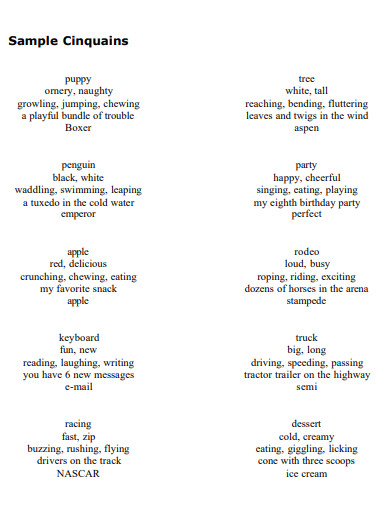
readwritethink.org
2. Cinquain Poem Rules Example
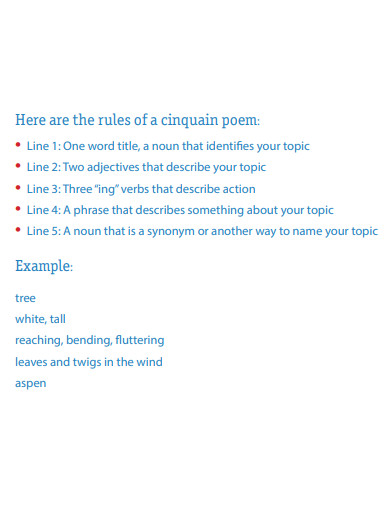
startwithabook.org
3. Summer Cinquain Poem Example
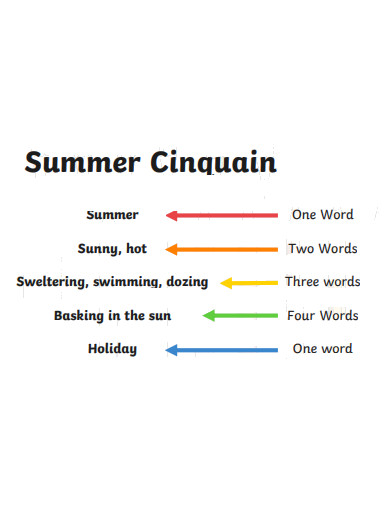
grangeton.uk
4. Cinquain Poem Worksheet Example
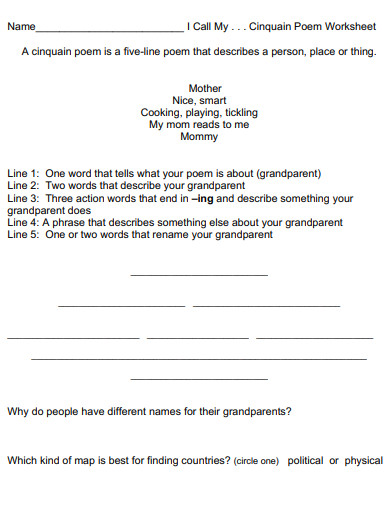
geoalliance.asu.edu
5. Cinquain Poem Example
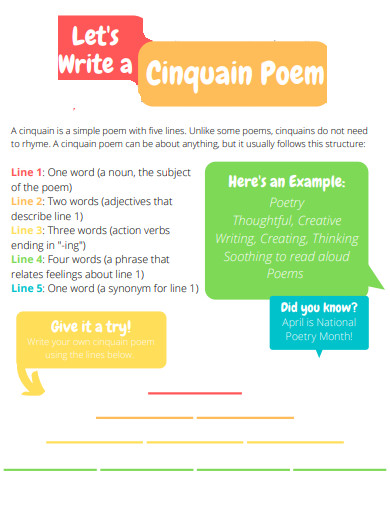
thefrickpittsburgh.org
6. Cinquain Poem Rubric Example
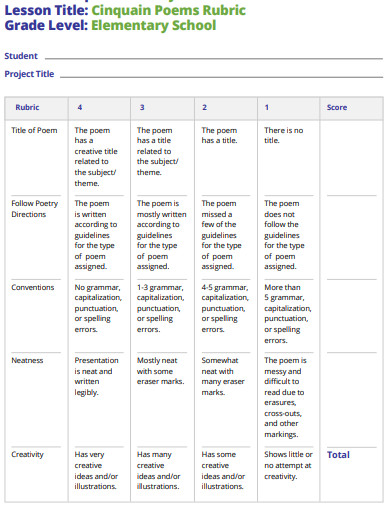
s3.amazonaws.com
7. How to Write Cinquain Poem Example
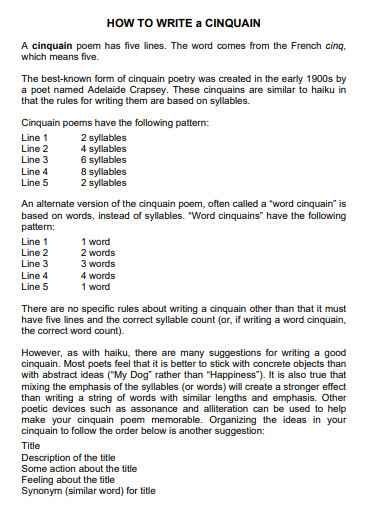
apps.asdk12.org
8. Cinquain Poem Lesson Plan Example
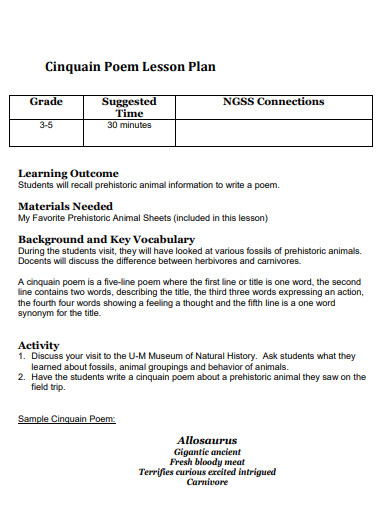
lsa.umich.edu
9. Cinquain Poem Template

mszamorano.edublogs.org
10. Simple Cinquain Poem Example
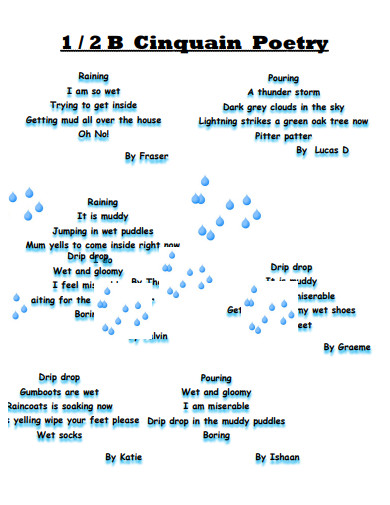
warrawee-p.schools.nsw.gov.au
11. Haiku And Cinquain Poem Example

lancaster.unl.edu
12. Didactic Cinquain Poem Example
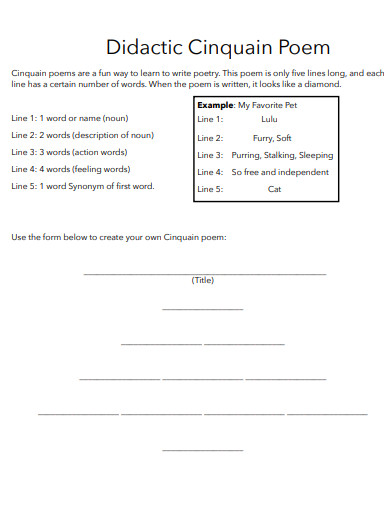
texasdeafed.org
13. Cinquain Poem Art Making Example
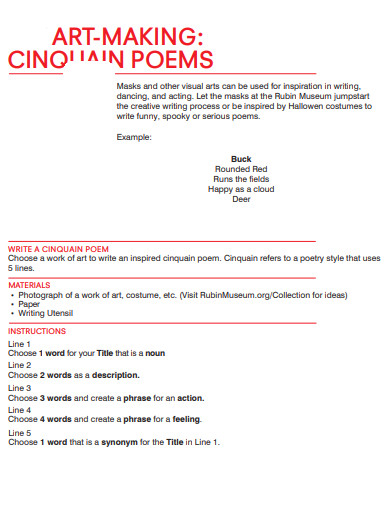
rubinmuseum.org
14. Writing Cinquain Poem Example
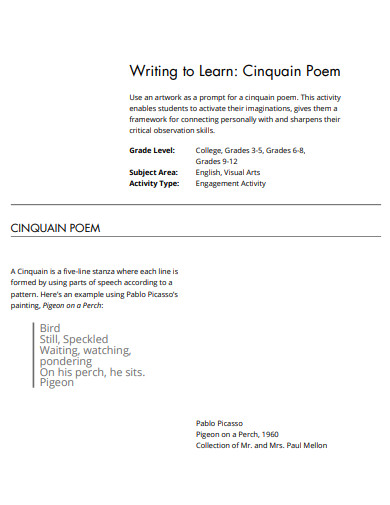
vmfa.museum
15. Animal Cinquain Poem Example
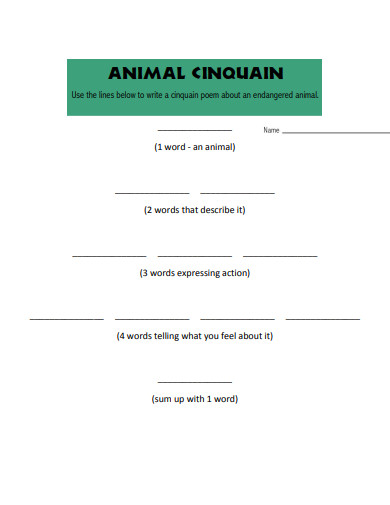
kidszoo.org
16. Own Cinquain Poem Example
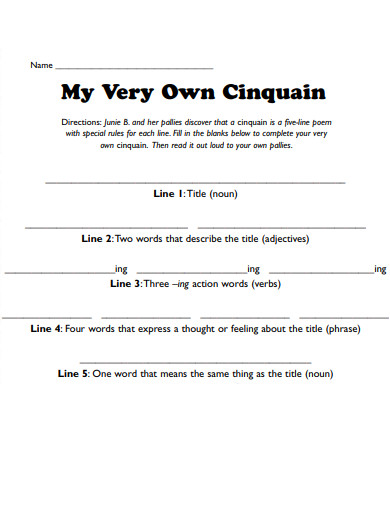
juniebjones.com
17. Brainstorming Cinquain Poem Example
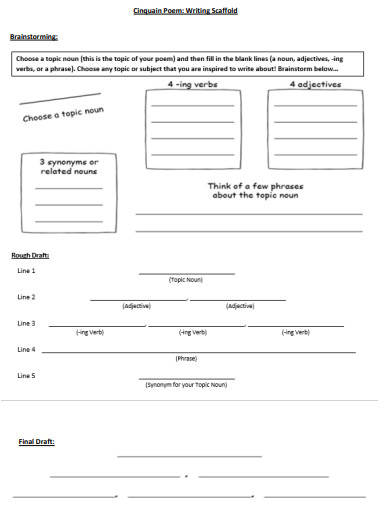
34auburn.weebly.com
18. Spring Cinquain Poem Example
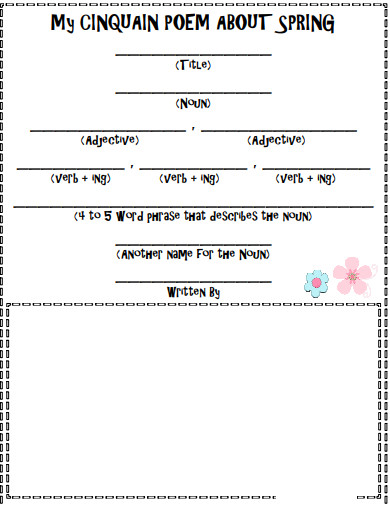
juneau.org
19. Blank Cinquain Poem Example
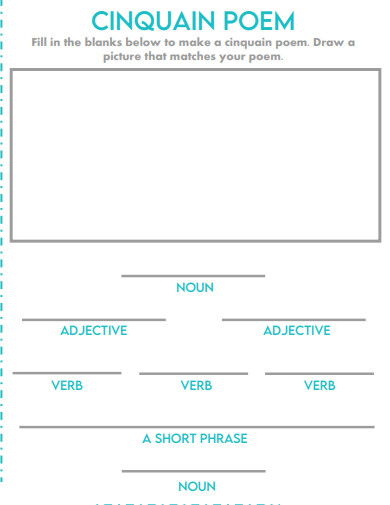
mtteducationstation.com
20. Cinquain Poem Fillable Example
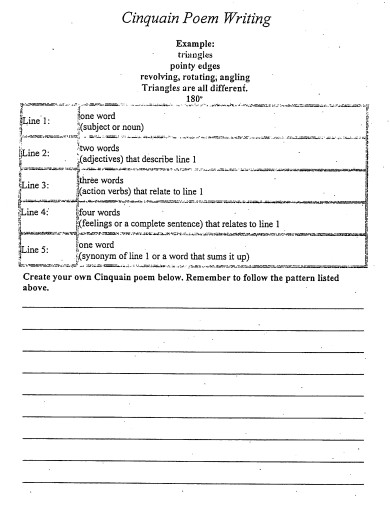
rrcs.org
21. Grade 4 Cinquain Poem Example
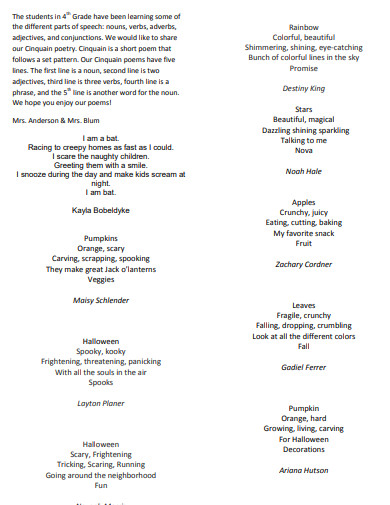
norfolkpublicschools.org
22. School Cinquain Poem Example

cdn.agclassroom.org
23. Cinquain Poem Frame Example
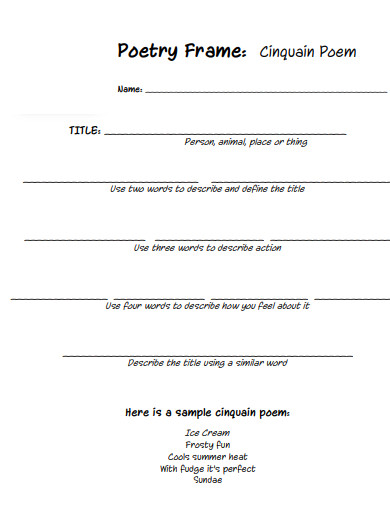
educationworld.com
24. Friendship Cinquain Poem Example
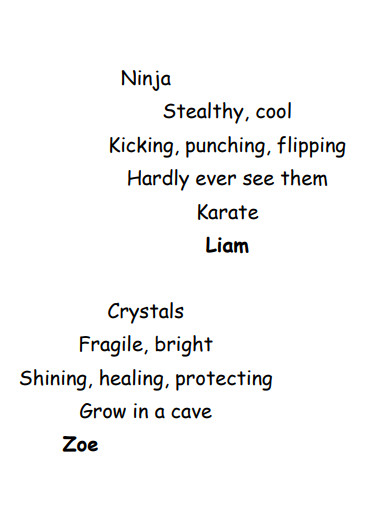
tootps.vic.edu.au
25. Cinquain Poem Instructions Example
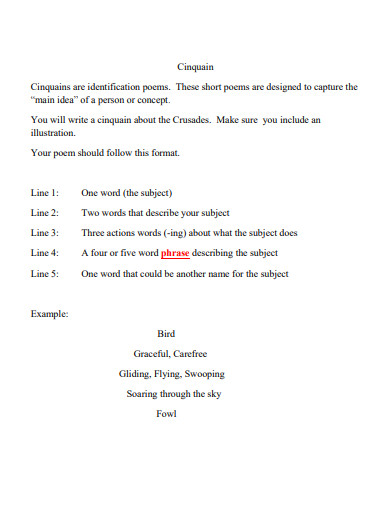
wsfcs.k12.nc.us
26. Draft Cinquain Poem Example

fieldcourtjunioracademy.co.uk
27. Cinquain Poetry Example
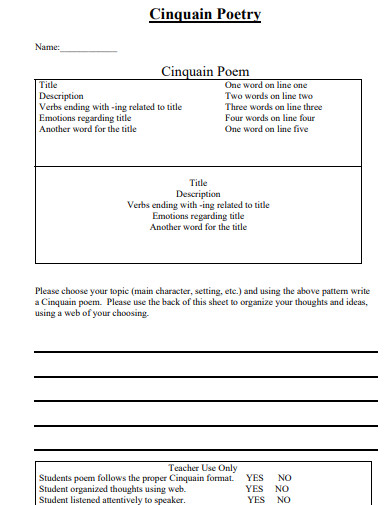
beaconlearningcenter.com
28. Family Cinquain Poem Example
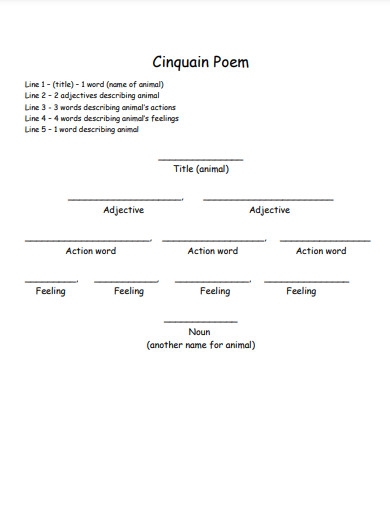
joliet86.org
29. Cinquain Poem Practice Example

/la01906411.schoolwires.net
30. Cinquain Poem Rough Draft Example
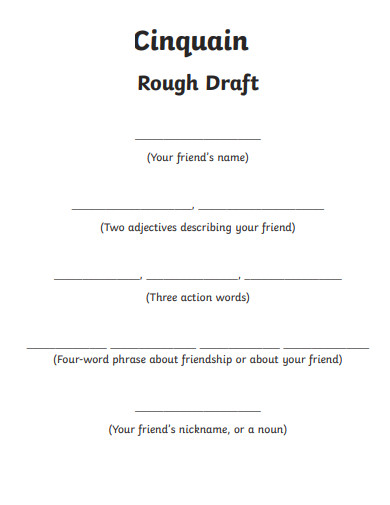
wransom.co.uk
31. Free Cinquain Poem Example
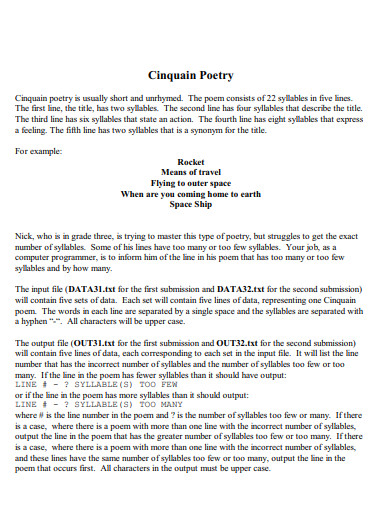
nayuki.io
Tips for Writing Cinquain Poems
Writing a Cinquain poem can be a delightful and expressive way to capture an image or emotion in words. Here are some tips to help you craft beautiful Cinquain poems:
Start with an Idea
- Choose a Subject: Start with a clear subject in mind. Cinquains work well with focused topics like nature, emotions, or everyday objects.
Understand the Structure
- Learn the Format: Familiarize yourself with the Cinquain structure. Whether you’re using the syllable pattern (2-4-6-8-2) or the word count method (one word/two words/three words/four words/one word), understanding the framework is crucial.
Use Descriptive Language
- Be Vivid: Use descriptive words and phrases to paint a vivid picture in the reader’s mind. Adjectives, verbs, and nouns should all work together to create a strong image or feeling.
Focus on Imagery
- Create Images: Think about how to visually convey your subject. Cinquains are compact, so every word should contribute to building a clear image or emotion.
Experiment with Word Placement
- Play with Words: Don’t be afraid to experiment with the placement of words and phrases within the poem’s structure. The flexibility can lead to surprising and delightful results.
Practice Economy of Language
- Be Concise: With a limited syllable or word count, each choice must be deliberate. Aim for brevity and precision in your language.
Edit and Refine
- Revise: Don’t hesitate to revise and refine your poem. Editing is a critical step in the process, helping to tighten your language and imagery.
Read Out Loud
- Hear the Rhythm: Reading your Cinquain out loud can help you catch any awkward phrasing or inconsistencies in rhythm, allowing you to make necessary adjustments.
Get Inspired
- Seek Inspiration: Read other Cinquains to get a feel for different styles and subjects. Inspiration can come from anywhere – nature, emotions, daily life, or even other forms of art.
Have Fun
- Enjoy the Process: Writing Cinquains should be an enjoyable creative exercise. Don’t put too much pressure on yourself, and remember to have fun with it.
FAQs
Can I use different syllable counts for my cinquain poem?
While traditional cinquains follow specific syllable patterns, creativity knows no bounds. You can experiment with variations, such as reverse cinquains or didactic cinquains, to suit your style and message.
What is the difference between a sonnet and a cinquain poem?
A sonnet is a 14-line poem with a specific rhyme scheme and meter, often used to explore themes of love and beauty. In contrast, a cinquain is a five-line poem with a fixed syllable structure, allowing for more brevity and versatility in themes.
Are cinquains suitable for expressing complex emotions?
Absolutely! The structured nature of cinquains can provide a concise yet powerful platform to convey complex emotions, thoughts, and ideas effectively.
How Do You Write a Cinquain Poem for Kids?
To write a cinquain poem for kids, introduce a simple structure like 2-4-6-8-2 syllables or a word count format (one word for the title, two adjectives, three action verbs, a four-word phrase, and one word that relates back to the title). Encourage creativity and the use of descriptive language.
How Are Cinquain Poems Written?
Cinquain poems are written following a specific format, typically a 2-4-6-8-2 syllable count across five lines, or a structure based on word count. Each line serves a unique purpose, from introducing the subject to providing a closing thought or image.
Does a Cinquain Poem Have a Title?
Yes, a cinquain poem often has a title. The title usually reflects the subject of the poem or can be the first word of the poem itself, especially in the didactic cinquain format used in educational settings.
What is a Free Cinquain Poem?
A free cinquain poem deviates from the traditional syllable or word count structures, allowing more flexibility in line length and syllable count. However, it still maintains the five-line format, focusing on vivid imagery and emotion.
What is a Characteristic of a Cinquain?
A characteristic of a cinquain is its concise, five-line structure. Depending on the variation, it follows specific syllable counts (2-4-6-8-2) or a pattern of words. Cinquains are known for their ability to convey vivid imagery and emotion efficiently.
What is a Cinquain for 6th Grade?
For 6th grade, a cinquain is a five-line poem that teaches students about syllable count and expressive writing. It can follow a 2-4-6-8-2 syllable pattern or a simple word count format, helping students focus on descriptive language and compact storytelling.
Does a Cinquain Need to Rhyme?
No, a cinquain does not need to rhyme. The focus is on the syllable count or word pattern and the concise expression of ideas or emotions. Rhyming is optional and not a required element of cinquain poetry.
Cinquain poems, with their structured elegance and succinct nature, offer poets a delightful canvas to paint their emotions and ideas. By following our step-by-step guide and drawing inspiration from the examples provided, you can embark on a poetic journey that unlocks the beauty of this art form. So, pick up your pen and let your words flow in the rhythmic dance of a cinquain poem, capturing the essence of your thoughts and emotions in just five lines.



